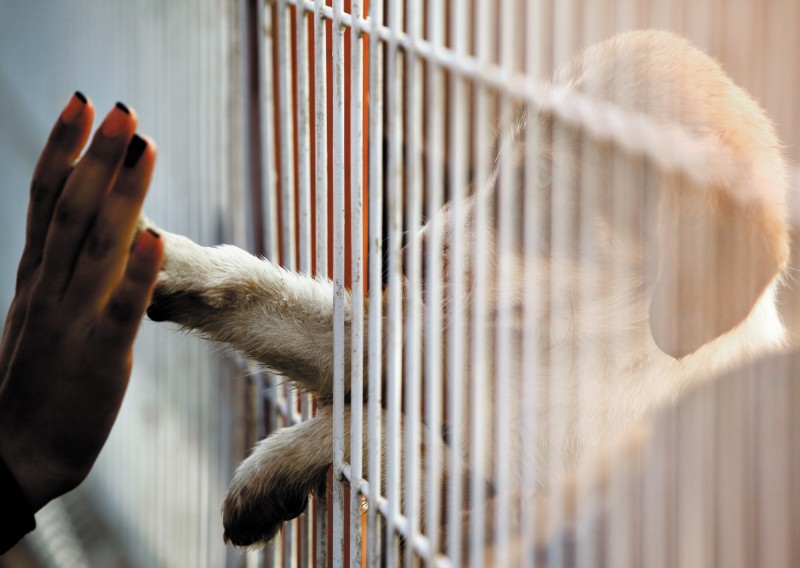Adopting a Shelter Pet: A Primer

So you’ve decided to adopt a shelter pet. Congratulations! Rescues and shelters have wonderful animals who are just waiting to be adopted into their forever homes. But adopting a new dog or cat is not all fun and games; it takes some real planning to make sure this new family member, along with everyone else in the household, has a smooth transition.
Volunteer Veterinary Hospital works with newly adopted pets and their people frequently, and we are happy to share our tips and ideas on adopting a shelter pet.
Before You Go
As we mentioned, there’s some serious planning that should take place before you set foot in a shelter to look for a new companion. Preparation and careful thought ahead of time will help make sure your new pet is successful in your home. Here are some tips:
Hold a family meeting – make sure everyone in your family is on board with the time, emotional, and financial commitment a new pet will take. Dogs can live up to 15 years, and cats into their early twenties, and will need lots of care every one of those days!
Check the requirements – many renters are not allowed to have pets, and even some homeowner associations have restrictions. Check your housing situation before going to the shelter, as most shelters require proof that your living situation allows a new pet.
Puppy proof your home – similar to a new baby, a new pet requires a little home preparation for safety’s sake. New pets – no matter how old – may be more prone to getting into things they shouldn’t than you expect. Put valuables out of reach, make sure toxic substances are safely stored. Make sure any areas you don’t want pets to reach are gated off.
Gather the essentials – there are necessities and creature comforts that you should have before bringing a new pet home. Food and water bowls, a sleeping spot, leashes and collars, a litter box, and toys and chews are all important items to have ready to go.
When You Go
Adopting a shelter pet is exciting and overwhelming. Keep in mind that most shelters have all the pets available for adoption on their websites. It might be helpful to look and see if any of the pets catches you eye, so that entering the shelter with all those adorable cats and dogs is not too overwhelming.
Talk to the staff – shelter staff are extremely knowledgeable about the creatures in their care. Talk to them about your lifestyle and what you’re looking for. Ask questions about the animal, including health history and what put them in the shelter.
Meet your future pet – meeting potential new pets is always exciting, but keep in mind that some pets can feel stress in a shelter environment. Realize that behaviors you may see – aloofness, tucked tail, and trembling may be a reaction to the shelter environment and not the true personality of the pet.
Adopting a Shelter Pet
Congratulations! You’ve adopted your new pet and you’re headed home. Now what?
Give them time – pets need a little time and space to get acclimated. Make sure your pet has a stable routine for feeding, walks, and sleeping. With love, gentleness, and time, you’ll see their personality bloom.
Bring them in – we would love to see your new shelter pet within 48 hours of adoption, if possible. This gives us a chance to get to know them and to help answer any questions you may have. Shelters normally have vaccinated and spayed or neutered pets they adopt, but we can talk about wellness, parasite control, nutrition, dental care, and any other needs your pet may have.
Go to a training class – getting to know your new pet is really fun, and a weekly training class together is a wonderful way to do this. It will help your new pet know what you expect, and will help teach you how to teach your pet. The more common language you share with your pet, the fewer behavioral issues will come up. Look for a training class that uses positive reinforcement. Give us a call for recommendations.
Keep asking questions – most shelters are wonderful resources for ongoing questions. If something doesn’t seem right, they are often more than willing to help.
Send pictures – a great way to say “thanks” to the shelter workers is to send pictures of your pet in her new happy home. A lot of shelter staff don’t get to say goodbye when pets are adopted, and it’s a nice way to give them a morale boost and thank them for their hard work and show them that the pet went to the right family.
If you have any questions before, during, or after adopting a shelter pet, please don’t hesitate to call us! We are more than happy to answer any questions or provide resources for you. And, as always, your team at Volunteer Veterinary Hospital looks forward to seeing you and your pets soon!

